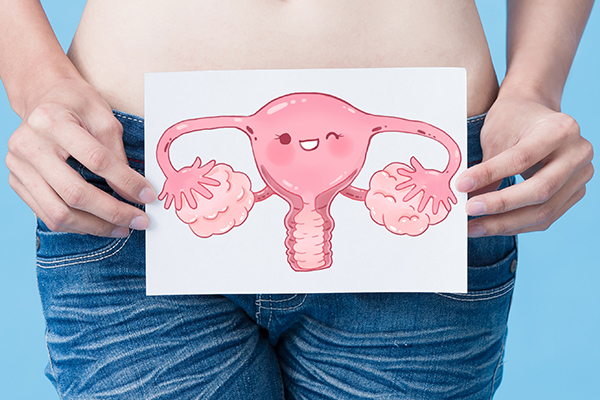In this article:
Uterine prolapse (1) is generally defined as the descent of the uterus into the vagina. The uterus is located within the pelvis along with the bladder, both of which are held in place atop the inside end of the vagina by a web of supportive muscles and ligaments.

These supportive structures can become loose and weak over time due to gradual wear and tear as well as stretching during pregnancy. Consequently, the uterus shifts downward, which is known as uterine prolapse.
In mild cases, the sagging uterus only creates a protrusion inside the vaginal canal with minimal symptoms that largely go unnoticed. In fact, nearly half of all pregnant women experience some degree of uterine or bladder prolapse in the aftermath of childbirth but remain oblivious to it due to the lack of symptoms.
More serious cases of uterine prolapse involve a drastic sinking of the uterus such that it becomes visible from the vagina’s opening or even sticks out of it. Treatment is warranted in such cases.
Different Stages of a Prolapsed Uterus
Stages 0 through 4 are the general stages of prolapse. However, some surgeons utilize other staging methods that are compartment specific. (2)
The severity of uterine prolapse is gauged based on how far the bladder, uterus, or bowel has sunk. The four general stages of severity are:
- First degree: There is only a slight downward shift in the position of the concerned organs.
- Second degree: The organs descend far enough to reach the level of the vaginal opening.
- Third degree: The vagina or uterus slips so far that 1 cm of it bulges out of the vaginal opening.
- Fourth degree: The organs drop down even further such that more than 1 cm of the vagina or uterus protrudes out of the vaginal opening.
Causes of Uterine Prolapse
The cause of uterine prolapse is multifactorial. The most common is pregnancy, but other causes include heavy lifting for prolonged periods. Patients who smoke are also at risk as smoking affects collagen production and can weaken connective tissue over time.
Some Common Symptoms of Uterine Prolapse
Many women will report pelvic or vaginal pressure. Sometimes, they will experience pelvic or low back pain. When the uterus sinks into the vagina, the bladder and rectum may also drop down (bladder and rectal prolapse).
Bladder prolapse can cause urinary symptoms such as frequency or urgency of urination and incomplete emptying of the bladder. Rectal symptoms include constipation or feeling of incomplete emptying of the bowels.
Treatment for Uterine Prolapse
Not all treatments are good for everyone. The treatment can be pelvic floor physical therapy to help some of the pelvic floor weakness. The use of a pessary can also be helpful.
A pessary is a silicone ring or other shaped device that is placed into the vagina by the doctor after being properly sized. This device can help elevate the prolapse and thereby alleviate the symptoms.
If these nonsurgical options do not help, then surgery can be done. Depending on the stage of prolapse, procedures such as laparoscopic uterosacral colpopexy, (3) sacrocolpopexy, (4) and sacrospinous fixation are all commonly done to repair a prolapse.
Your surgeon will tailor the surgical management to your specific stage of prolapse and desired outcomes.
Diagnosis of a Uterine Prolapse
Your doctor will stage the prolapse during a pelvic exam with the use of a speculum. They may ask you to bear down during the exam to elicit the prolapse and determine its stage. They may ask you to stand and bear down as well to fully evaluate the prolapse.
Complications of a Prolapsed Uterus
The complications of uterine prolapse broadly depend on the stage of prolapse.
In most cases, women who have stage 1 or 2 prolapse will not experience any significant symptoms. However, stages 3 and 4 could have complications as the surrounding organs may be affected.
Most-Asked Questions About Uterine Prolapse

Can a prolapsed uterus cause bleeding?
Bleeding directly from the uterus in a postmenopausal woman could be cancer and needs to be evaluated. However, if a woman has bleeding and a prolapse, her doctor will need to rule other causes and sites of bleeding.
Ulceration of the prolapsed walls could be a common reason, or the bleeding may be from her bladder or rectum.
Is it normal for a prolapsed uterus to be accompanied by pain?
Pain can be normal but also many women can have a prolapse for years with little impact on their lives. But pelvic pressure, pain, and generalized discomfort are common reasons women will seek medical attention.
Is a prolapsed uterus dangerous?
A prolapse is rarely a dangerous diagnosis. However, stage 4 prolapse that cannot be reduced may lead to obstruction of urination and renal failure.
Along that line, prolapse that cannot be reduced also may lead to decubitus ulceration, which could become infected and cause sepsis.
Is it advisable to push a prolapsed uterus back up?
If a woman sees a prolapse, her instinct would be to try to reduce it. However, she should seek specialized care and consultation as soon as possible to be sure it is not something more concerning, such as a mass related to cancer.
Can exercising worsen a prolapsed uterus?
If a woman has a prolapse already, vigorous weight-bearing exercising could worsen the prolapse. However, light cardio workouts, yoga, etc., can be continued safely.
Can a woman suffering from uterine prolapse get pregnant?
The simple answer is yes.
Is uterine prolapse dangerous during pregnancy?
The pregnancy itself is not likely to be at any risk due to the prolapse. Also, it is important to know that a woman with a known prolapse who is pregnant may notice a worsening of her prolapse up to a year after her delivery and any surgical intervention should be delayed until then.
Final Word
If you feel you have a prolapse, see a doctor who specializes in female pelvic floor disorders and also performs surgeries for these conditions. There may not be a one-size-fits-all correction of prolapse and it may take many months or years to get the results you are comfortable with.
Many women feel embarrassed by the prolapse and may not talk to anyone about it. Women should know that they are not alone and that many women experience this. There are nonsurgical methods to help address the symptoms of prolapse, and women should not be afraid to ask their doctor about all their options.
- Was this article helpful?
- YES, THANKS!NOT REALLY


